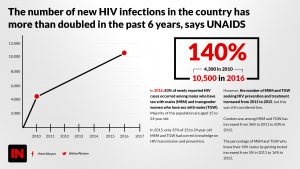
MANILA, Philippines — With new infections more than doubling over the past six years, the Philippines now has the fastest growing HIV epidemic in Asia and the Pacific, the Joint United Nations Program on HIV/AIDS or UNAIDS said.
The country was one of the eight in the region that account for more than 90 percent of new infections, the agency added.
The UNAIDS said its report on the global HIV epidemic showed that the Philippines registered 10,500 new infections in 2016, a 140 percent increase from the estimated 4,300 in 2010.

But despite the country’s having the fastest percentage increase, the UN agency said the “number of new infections is not as high as several countries in the region which are estimated to have tens of thousands of new infections annually.”
The country thus “has a small window of opportunity to act now and stop a major HIV epidemic from taking hold,” Eamonn Murphy, director of the UNAIDS Regional Support Team for Asia-Pacific, said in a statement.
“If HIV programming is redirected to focus on the people most at risk and where they are located, I’m sure the country can not only return to a stable situation but even end the AIDS epidemic as a public health threat by 2030,” Murphy said.
UNAIDS said the Philippines has managed to control the spread of HIV among female sex workers but also seen a shift to other key risk populations since 2007.
“The Philippine data showed that in 2016, 83 percent of newly reported HIV cases occurred among males who have sex with males and transgender women who have sex with males,” with “the majority of the new infections … occurring among 15 to 24 year old MSM and TGW,” it said.
While it noted an increase in condom use among MSM and TGW — from 36 percent in 2011 to 50 percent in 2015 — as well as “the percentage of MSM and TGW who knew their HIV status by getting tested” — from 5 percent in 2011 to 16 percent in 2015 — UNAIDS said “this still remains low.”
It also said only 35 percent of 15-24 year old MSM and TGW “had correct knowledge on HIV transmission and prevention” in 2015.
At the same time, it said the country “has retooled its program to expand HIV services for males who have sex with males and transgender women and has opened clinics that cater specifically to their needs in urban areas, where the risk of HIV is higher.”
The strategy targets “117 cities where 80 percent of the new infections have been reported and to open in each such city at least one HIV clinic which has convenient evening hours for working people, and is a one-stop shop that provide prevention, counseling, laboratory work-up, and treatment services.”
“The government has also taken measures towards enabling rapid HIV screening and delivery of test results,” UNAIDS added.
The agency noted that Health Secretary Paulyn Jean Rosell-Ubial has acknowledged HIV as “one of the top health priorities for the government of the Philippines,” pointing out that her department gives up to P30,000 worth of free antiretroviral medicine a year and provides other out-patient services to those who test positive.
“Between 2013 and 2015, the government increased funding for the HIV program, and now shoulders 70 percent of all financing for its response,” it also noted.
The UN agency also acknowledged the stepped up efforts of local governments, citing the three “Sundown clinics” opened by Quezon City that provide “rapid HIV testing and counseling for MSM and TGW, as well as HIV treatment in a non-stigmatizing environment.”









